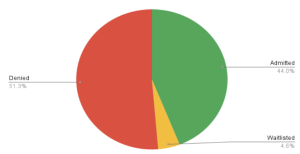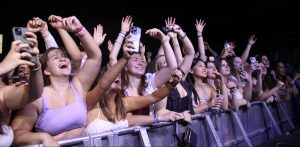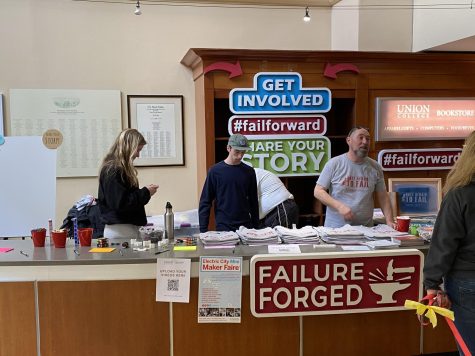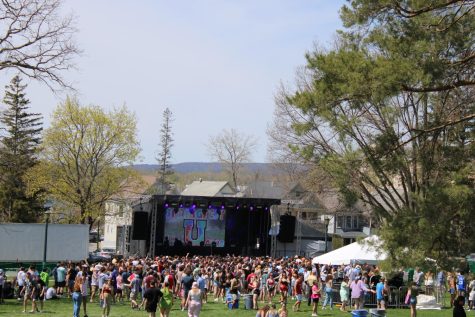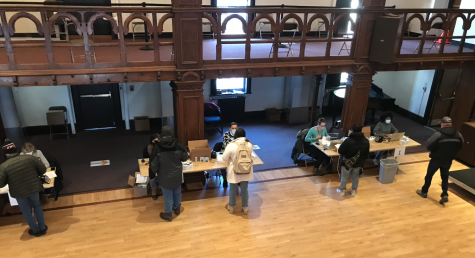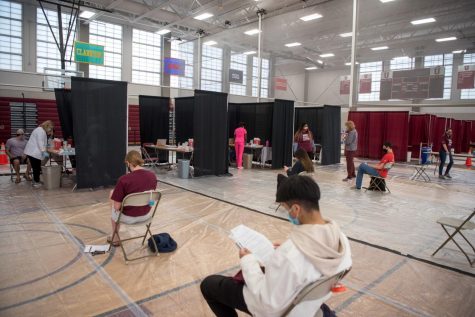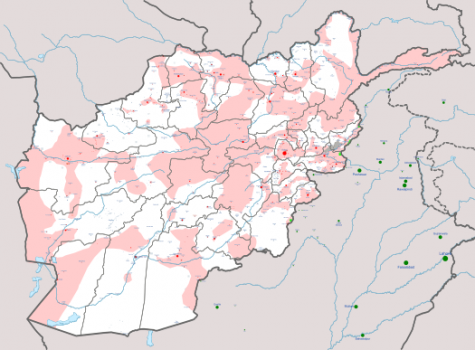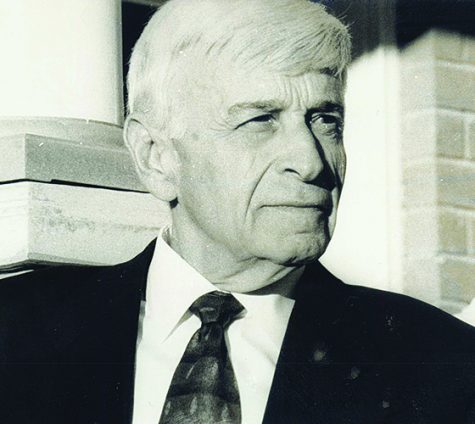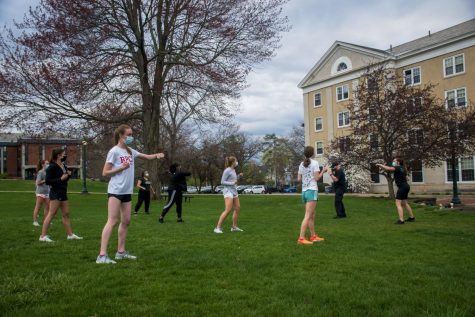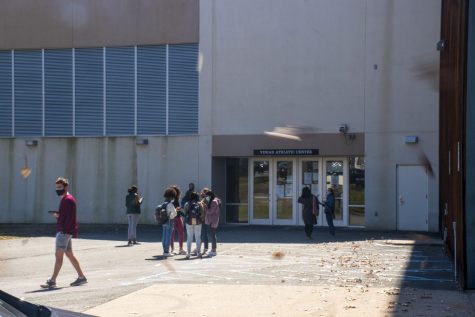Students display research, art, at 28th Steinmetz Symposium
May 17, 2018
Students presented and displayed their work as part of the annual Steinmetz Symposium on Friday, May 11. The day also included performances of music and dance. Classes for that day were cancelled so students could present their research and attend their peers’ presentations.
“The best thing out of [creating my thesis] was the opportunity to do all the research, to get the know the whole process,” said Daniel Giroux ’18. He said it was, “not just using what’s available, but reaching out and getting more.”
When students were asked about what their greatest take away from the thesis process, answers were pretty consistent across all disciplines.
“It really comes down to getting that experimental experience,” stated Andrew Attori ’18. Attori was a part of the Union College Rocket Team which presented their rocket design, which was nearly 10 feet tall, in Wold during the poster session.
“Our first test rocket blew up,” Attori said. He went on to explain, “It wasn’t our fault. It was a motor causing failure and most of the things we designed were validated.” They have since rebuilt and continue to prepare for their upcoming competition, where, according to Attori, they can get, “more of that hands on experience and see in action the things we’d read.”
The day was split up into five sessions. The first and last two sessions were oral presentations
given by students throughout the day, while the third session consisted of poster presentations, engineering project displays and Minerva Fellows in Schaffer Library and the Wold Atrium. Students from all disciplines presented their work.
“Being able to do something on [my passion] in academic form was really a lot of fun,” Zachary Fischer ’18 said.
Rachel Clarey ’18 presented her research on the Writing Center and programs for first year international students coming to Union College.
She worked in the Writing Center for two years, assisting people who speak English as a second language despite her lack of formal training in the area. She observed the isolation of international students in the larger school community.
From her research, Clarey concluded that, “[there] needs to be a bigger support system for international students. It’s a trend in higher education to market to international students because they bring in higher revenue and increase diversity, but if you’re going to do that you need to provide more support.”
Other projects were focused on more theoretical topics. Matthew Barrett ’18 gave a presentation on the Fibonacci Sequence and metallic means, or sequences derived from the Fibonacci Number.
Kim Wellington ’18 created an agent-based computer model to analyze the effectiveness of different components of the 2009 stimulus package.
The was a variety of both research-based and productbased projects presented throughout the day.
“It was very gratifying to be able to see [my] piece come to life. It’s always very different having a piece in your head to having it on paper, let alone to having it be performed,” Elyse Clark ’18 said of her senior thesis “North Woods”, which was performed during Steinmetz.
The next day, Clark was awarded the Victor Herbert Prize, given “to the student who has the most promise to contribute to American music.”
The majority of students have to do a thesis of some sort in order to graduate and part of that process is picking an advisor.
During the process, students work closely with their advisors, often for large numbers of hours.
When students were asked anonymously how their advisors were, the overwhelming majority had positive feedback.
One student remarked that, “He was willing to come in on a Saturday for several hours… I really appreciated the help, and I’ve got to give him more thanks.”
Most students said that they had a great experience working with their advisor, finding them to be an invaluable resource.
“[He] was really helpful when I was struggling. We were able to figure it out in an hour where I was struggling for days.”
One student went as far as to say that he had “nothing negative” to say about his advisor at all.
The only negative comment that was received about any advisor was from a student whose advisor was on sabbatical, which the student even commented was not their fault.
“Find a professor who respects you and who you really respect in return and then I promise it’ll be a great experience,” one student said.
In addition to the presentations, there was a dance performance in the Nott Memorial at 4:00 p.m., an orchestra and choir concert in Memorial Chapel at 8:00 p.m. and a performance by the Jazz Ensemble the next day in Emerson Auditorium at 2:00 p.m.
The dance performance featured 20 performances by dance students and clubs alike.
“It’s a beautiful show and you can see all the hard work the dancers put in,” Minh Le ’20 said.
Among the performers was Megan Wells ’18, who performed in three numbers and choreographed one.
Wells, who is a biology and theater double major and a dance minor, has been in four dance shows and over six plays at Union and was awarded the Hedda Hainebach Memorial Prize in Theater and Dance for Best Actress.
“It’s so rewarding after four years of being in the department to win this in something I’m going to pursue after college,” Wells said.
In addition to Wells, Shannon West ’19 and Danielle Pinney ’20 were awarded the Edward Villella Fellowship and Ayanah “Tris” Dowdye ’18 was recognized for her contributions to the Theater and Dance Departments during the last two years.
Dance Program Director Miryam Moutillet was also awarded the first Gustav L. Davis ’59 and Susan S. Davis Director of Dance.
Later that night, the Steinmetz Symposium Concert took place.
Among the songs performanced was Clark’s work, which was performed by the Union College and Community Orchestra and “Chun Xiao,” a choral arrangement done by Chujun Li ’18 to the words of a Chinese poem of the same name written by Meng Haoran in the eighth century.On Prize Day, Li was awarded the Charles Alexander Prize in Music.
“I feel very good about it. The orchestra did amazingly. It’s just as much them as me,” Clark said.
In addition to Clark’s composition, the orchestra performed Pyotr Ilyich Tchaikovsky’s Symphony No. 5 in E minor, Op. 64, Carl Maria von Weber’s Clarinet Concerto No. 2 in E-flat major, Op. 74 where Leo Minami ’21, the first prize winner of the 2018 Steinmetz Concerto Competition, played the solo and “The Wounded Heart” from Two Elegiac Melodies, Op. 34 by Edvard Grieg, which was conducted by Alexander Heywood ’20.
Before Li’s piece, The Union College Choir performed Psalm 131 in its entirety and the first verse of Psalm 133, both in Hebrew. Li, Clark and William Garner ’18 had solos during these songs.
Afterwards, they played a medley of songs from “Candide” and “West Side Story,” all of which were written by Leonard Bernstein.
For the songs from Candide, “The Best of All Possible Worlds” and “Make Our Garden Grow,” members of the choir dressed up in costumes and carried props to resemble characters in both the play Candide and the book, which was written by Voltaire.
Nate Gillespie ’20, who played the character of Pangloss, described the performance as “exhilarating.” The Heavenly Voices Gospel Choir accompanied the Union College Choir in the song “America.”
This song featured soloists Li and Portia Taylor ’19 as well as dancing from large numbers of both choirs on stage, in the aisles and in front of the audience.
“This allows all of us to explore different genres of music,” Director of the Gospel Choir Lyndon Walters said.
The songs from West Side Story all featured soloists who were given props and costumes
to act while they sung. Clark and Ryan Bosanko ’21 acted the role of Maria and Tony during “Something is Coming,” “Tonight,” “One Hand, One Heart” and “Somewhere.”
According to Gillespie, rehearsals leading up to the performance were “intense, some went on as long as ten hours.”
The last three songs of the program, “One Hand, One Heart,” “Somewhere” and “Make Our Garden Grow” were done in succession with musical transitions between the three of them.
Professor Shou-Ping Liu, who conducted for both the orchestra and choir, stated that the purpose of this was to both “try and make [the audience] cry” and to convey a message.
“It was a lot of fun doing this. I really enjoyed working with all these people, especially our accompaniments, especially by good friend Tim who was rocking the bass,” Bosanko said.
In addition to Timothy Maines ’21, who played the bass, the choir was also accompanied by Richard Boakye ’20 on the drum set.
“I enjoy every experience because it teaches me more. It opens me to new opportunities and it helps me grow as a drummer,” Boakye said.
The next day the Jazz Ensemble, directed by Professor Tim Olsen, performed “In the Mood” by Joe Garland, “St. Louis Blues March” by W.C. Handy, “Blue” by Bobby Shrew, “Tank!” by Yoko Kanno, “Blue” by Thomas Gansch, “Bugler’s Holiday” by Leroy Anderson, “Four Brothers” by Jimmy Giuffre and “Hey Jude” by John Lennon and Paul Mccartney.
“It was really fun. We had a good time just enjoying the music and sharing our enjoyment with other people,” Jazz Ensemble bassist Cato Tran ’21 said.

